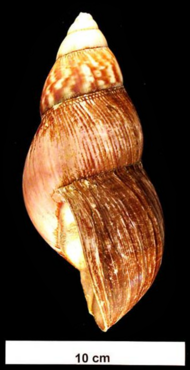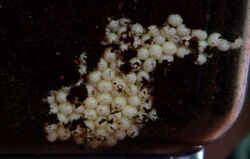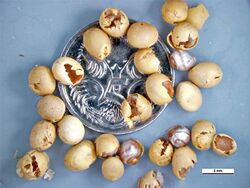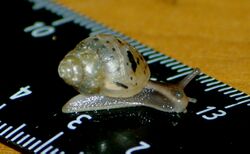Biology:Achatina fulica
| Achatina fulica | |
|---|---|
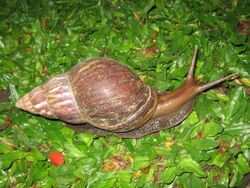
| |
| Achatina fulica in Bali, Indonesia | |
| Scientific classification | |
| Domain: | Eukaryota |
| Kingdom: | Animalia |
| Phylum: | Mollusca |
| Class: | Gastropoda |
| Subclass: | Heterobranchia |
| Order: | Stylommatophora |
| Suborder: | Achatinina |
| Superfamily: | Achatinoidea |
| Family: | Achatinidae |
| Genus: | Achatina |
| Species: | A. fulica
|
| Binomial name | |
| Achatina fulica (Férussac, 1821)
| |
| Synonyms | |
| |
Achatina fulica is a species of large land snail that belongs in the family Achatinidae. It is also known as the Giant African land snail.[1][2] It shares the common name "giant African snail" with other species of snails such as Achatina achatina and Archachatina marginata.
This snail species has been considered a significant cause of pest issues around the world. Internationally, it is the most frequently occurring invasive species of snail.[3]
Outside of its native range, this snail thrives in many types of habitat in areas with mild climates. It feeds voraciously and is a vector for plant pathogens, causing severe damage to agricultural crops and native plants. It competes with native snail taxa, is a nuisance pest of urban areas, and spreads human disease.[1] This snail is listed as one of the top 100 invasive species in the world.[4]
Subspecies
Subspecies within this species:
- Achatina fulica hamillei Petit, 1859[5]
- A. f. rodatzi Dunker, 1852
- A. f. sinistrorsa Grateloup, 1840
- A. f. umbilicata Nevill, 1879
Distribution
The species is native to East Africa,[5] but it has been widely introduced to other parts of the world through the pet trade, as a food resource, and by accidental introduction.[6]
This species has been found in China since 1931[7] and its initial point of distribution in China was Xiamen.[8] The snail has also been established on Pratas Island, of Taiwan,[9] throughout India , the Pacific, Indian Ocean islands, Southeast Asia[10][6] and the West Indies. The species was established in the United States in 1936. They were brought to the U.S. through imports. They were intended to be used for educational uses and to be pets. Some were also introduced because they were accidentally shipped with other cargo.[11] Eradication is currently underway in Florida.[12]
The species has recentlyTemplate:Reltime been observed in Bhutan (Gyelposhing, Mongar), where it is an invasive species. It has begun to attack agricultural fields and flower gardens. It is believed there that dogs have died as a result of consuming the snail and being infected by the rat lungworm, Angiostrongylus cantonensis.[citation needed]
Starting in 2010,[13] individuals of the species have been found in the humid, subtropical Argentine Mesopotamia. The National Agricultural Health Service has established an ongoing project to detect, study, and prevent the expansion of this pest.[14]
In early April 2021, USCBP intercepted 22 being smuggled from Ghana into the US, along with various other prohibited quarantine items.[15]
Description
The adult snail is around 7 cm (2.8 in) in height and 20 cm (7.9 in) or more in length.
The shell has a conical shape, being about twice as high as it is broad. Either clockwise (dextral) or counter-clockwise (sinistral) directions can be observed in the coiling of the shell, although the dextral cone is the more common. Shell colouration is highly variable, and dependent on diet. Typically, brown is the predominant colour and the shell is banded.[16] The shell is particularly tough and has the highest heavy metal content of any snail species.
Ecology
Habitat
The giant African snail is native to East Africa, and can be traced back to Kenya and Tanzania. It is a highly invasive species, and colonies can be formed from a single gravid individual. In many places, release into the wild is illegal. Nonetheless, the species has established itself in some temperate climates and its habitat now includes most regions of the humid tropics, including many Pacific islands, southern and eastern Asia, and the Caribbean. The giant snail can now be found in agricultural areas, coastland, natural forest, planted forests, riparian zones, scrub and shrublands, urban areas, and wetlands.
Feeding
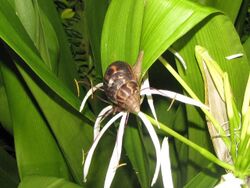
The giant African snail is a macrophytophagous herbivore; it eats a wide range of plant material, fruit, and vegetables, paper, and cardboard. It sometimes eats sand, very small stones, bones from carcasses, and even concrete as calcium sources for its shell. In rare instances, the snails consume each other, snail eggs, and other deceased small animals such as mice and birds.
In captivity, this species can be fed on a wide range of fruit and vegetables, plain unseasoned mince, or boiled egg. They should also always be provided with cuttlefish bone or egg shells, which are commonly used as a calcium source, vital for healthy shell growth. They require about 18.28% of crude protein in their diet for optimal growth.[17]
Lifecycle
This species is a simultaneous hermaphrodite; each individual has both testes and ovaries and is capable of producing both sperm and ova. Instances of self-fertilization are rare, occurring only in small populations. Although both snails in a mating pair can simultaneously transfer gametes to each other (bilateral mating), this is dependent on the size difference between the partners. Snails of similar size can reproduce in this way. Two snails of differing sizes mate unilaterally (one way), with the larger individual acting as a female, due to the comparative resource investment associated with the different sexes.[citation needed]
Like other land snails, these have intriguing mating behaviour, including petting their heads and front parts against each other. Courtship can last up to half an hour, and the actual transfer of gametes can last for two hours. Transferred sperm can be stored within the body up to two years. The number of eggs per clutch averages around 200. A snail may lay five to six clutches per year with a hatching viability around 90%.
Adult size is reached in about six months, after which growth slows, but does not cease until death. Life expectancy is commonly five to six years in captivity, but the snails can live for up to 10 years. They are active at night and spend the day buried underground.
The giant African snail is capable of aestivating up to three years in times of extreme drought, sealing itself into its shell by secretion of a calcareous compound that dries on contact with the air.
Parasites
Parasites of Achatina fulica include:
- Aelurostrongylus abstrusus[18]
- Angiostrongylus cantonensis – causes eosinophilic meningoencephalitis[18]
- Angiostrongylus costaricensis – causes abdominal angiostrongyliasis[18]
- Schistosoma mansoni – causes schistosomiasis, detected in faeces[19]
- Trichuris spp. – detected in faeces[19]
- Hymenolepis spp. – detected in faeces[19]
- Strongyloides spp. – detected in faeces and in mucous secretion[19]
As an invasive species
In many places, this snail is a pest of agriculture and households, with the ability to transmit both human and plant pathogens. Suggested preventive measures include strict quarantine to prevent introduction and further spread. This snail has been given top national quarantine significance in the United States.[20] In the past, quarantine officials have been able to successfully intercept and eradicate incipient invasions on the mainland USA.[21]
They are also known to damage buildings by eating stucco and similar materials for the calcium.[22]
In the wild, this species often harbors the parasitic nematode Angiostrongylus cantonensis, which can cause a very serious meningitis in humans. Human cases of this meningitis usually result from a person having eaten the raw or undercooked snail, but even handling live wild snails of this species can infect a person with the nematode, thus causing a life-threatening infection.[23]
In some regions, an effort has been made to promote use of the giant African snail as a food resource to reduce its populations. However, promoting a pest in this way is a controversial measure, because it may encourage the further deliberate spread of the snails.
One particularly catastrophic attempt to biologically control this species occurred on South Pacific Islands. Colonies of A. fulica were introduced as a food reserve for the American military during World War II and they escaped. A carnivorous species (Florida rosy wolfsnail, Euglandina rosea) was later introduced by the United States government, in an attempt to control A. fulica, but the rosy wolf snail instead heavily preyed upon the native Partula snails, causing the extinction of most Partula species within a decade.
Human use
These snails are used by some practitioners of Candomblé for religious purposes in Brazil as an offering to the deity Oxalá. The snails substitute for a closely related species, the African giant snail (Archachatina marginata) normally offered in Nigeria. The two species are similar enough in appearance to satisfy religious authorities.[24] They are also edible if cooked properly.[25] In Taiwan, this species is used in the dish of 炒螺肉 (fried snail meat), which is a delicacy among the traditional drinking snacks. L. fulica also constitutes the predominant land snail found in Chinese markets, and larger species have potential as small, efficient livestock.[26]
The snails have also become increasingly popular as pets[27][28][29] in countries including France and the UK,[30] where various companies have sold the animal both as a pet and an education aide.[31] L. fulica is one of the most common snails being sold in the pet trade.[citation needed]
The heparinoid acharan sulfate is isolated from this species.[32]
References
This article incorporates CC BY-2.0 text from the reference.[24]
- ↑ 1.0 1.1 Achatina fulica. Global Invasive Species Database. ISSG. IUCN.
- ↑ Bouchet, P. (2016). Achatina fulica (Férussac, 1821). In: MolluscaBase (2016). Accessed through: World Register of Marine Species at http://www.marinespecies.org/aphia.php?p=taxdetails&id=881469 on 2016-12-31
- ↑ Thiengo, Silvania (September 21, 2006). "Rapid spread of invasive snail in South America: the giant African snail, Achatina fulcia, in Brasil". Biological Invasions 9 (6): 693–702. doi:10.1007/s10530-006-9069-6. http://www.tsusinvasives.org/dotAsset/d182152a-80e6-425b-b913-d42e48d64829.pdf.
- ↑ View 100 of the World's Worst Invasive Alien Species. Global Invasive Species Database. ISSG. IUCN.
- ↑ 5.0 5.1 Rowson, B.; Warren, B.; Ngereza, C. (2010). "Terrestrial molluscs of Pemba Island, Zanzibar, Tanzania, and its status as an "oceanic" island". ZooKeys (70): 1–39. doi:10.3897/zookeys.70.762. PMID 21594041.
- ↑ 6.0 6.1 Fontanilla, Ian Kendrich C.; Maria, Inna Mikaella P. Sta; Garcia, James Rainier M.; Ghate, Hemant; Naggs, Fred; Wade, Christopher M. (2014-09-09). "Restricted Genetic Variation in Populations of Achatina (Lissachatina) fulica outside of East Africa and the Indian Ocean Islands Points to the Indian Ocean Islands as the Earliest Known Common Source". PLOS One 9 (9): e105151. doi:10.1371/journal.pone.0105151. ISSN 1932-6203. PMID 25203830. Bibcode: 2014PLoSO...9j5151F.
- ↑ Lv, S.; Zhang, Y.; Liu, H. X.; Hu, L.; Yang, K.; Steinmann, P.; Chen, Z.; Wang, L. Y. et al. (2009). "map of distribution in 2007". PLOS Neglected Tropical Diseases 3 (2): e368. doi:10.1371/journal.pntd.0000368. PMID 19190771.
- ↑ Lv, S.; Zhang, Y.; Liu, H. X.; Hu, L.; Yang, K.; Steinmann, P.; Chen, Z.; Wang, L. Y. et al. (2009). Knight, Matty. ed. "Invasive Snails and an Emerging Infectious Disease: Results from the First National Survey on Angiostrongylus cantonensis in China". PLOS Neglected Tropical Diseases 3 (2): e368. doi:10.1371/journal.pntd.0000368. PMID 19190771. figure 5.
- ↑ Wu S.-P., Hwang C.-C., Huang H.-M., Chang H.-W., Lin Y.-S. & Lee P.-F. (2007). "Land Molluscan Fauna of the Dongsha Island with Twenty New Recorded Species". Taiwania 52(2): 145-151. PDF
- ↑ Foon, Junn Kitt; Clements, Gopalasamy Reuben; Liew, Thor-Seng (2017-04-07). "Diversity and biogeography of land snails (Mollusca, Gastropoda) in the limestone hills of Perak, Peninsular Malaysia" (in en). ZooKeys (682): 1–94. doi:10.3897/zookeys.682.12999. ISSN 1313-2970. PMID 28769723.
- ↑ "National Agriculture Library". March 17, 2016. https://www.invasivespeciesinfo.gov/profile/giant-african-snail.
- ↑ Campo-Flores, Arian. October 4th, 2011. "Giant Alien Snails Attack Miami, Though They're Not in Much of a Rush: Eradication Teams Go House to House, Nabbing 10,000 Invaders; 'Crunch Under Our Feet'." Wall Street Journal. Link
- ↑ "Caracol Gigante Africano en Argentina". 30 June 2013. http://www.sanidadvegetal.com.ar/2013/06/caracol-gigante-africano-en-argentina.html.
- ↑ "Detección de Caracol Gigante Africano en la ciudad de Corrientes" (in es). 12 November 2013. http://www.senasa.gob.ar/senasa-comunica/noticias/deteccion-de-caracol-gigante-africano-en-la-ciudad-de-corrientes.
- ↑ "JFK Airport CBP Catches Highly Invasive Giant African Snails in Man’s Baggage". 2021-04-06. http://www.cbp.gov/newsroom/local-media-release/jfk-airport-cbp-catches-highly-invasive-giant-african-snails-man-s.
- ↑ Skelley, PE; Dixon, WN; and Hodges, G. 2011. Giant African land snail and giant South American snails: field recognition. Florida Department of Agriculture and Consumer Services. Gainesville, Florida. PDF
- ↑ (in Portuguese) Soares C. M., Hayashi C., Gonçalves G. S., Nagae M. Y. & Boscolo W. R. (1999). "Exigência de proteína para o caracol gigante (Achatina fulica) em fase de crescimento. Protein requirements for giant snail (Achatina fulica) during the growth phase". Acta Scientiarum. Animal Sciences 21(3): 683-686. abstract, PDF.
- ↑ 18.0 18.1 18.2 Ohlweiler, F. P.; Guimarães, M. C. D. A.; Takahashi, F. Y.; Eduardo, J. M. (2010). "Current distribution of Achatina fulica, in the State of São Paulo including records of Aelurostrongylus abstrusus (Nematoda) larvae infestation". Revista do Instituto de Medicina Tropical de São Paulo 52 (4): 211–214. doi:10.1590/S0036-46652010000400009. PMID 21748230. PDF.
- ↑ 19.0 19.1 19.2 19.3 (in Spanish) Libora M., Morales G., Carmen S., Isbelia S. & Luz A. P. (2010). "Primer hallazgo en Venezuela de huevos de Schistosoma mansoni y de otros helmintos de interés en salud pública, presentes en heces y secreción mucosa del molusco terrestre Achatina fulica (Bowdich, 1822). [First finding in Venezuela of Schistosoma mansoni eggs and other helminths of interest in public health found in faeces and mucous secretion of the mollusc Achatina fulica (Bowdich, 1822)]. Zootecnia Tropical 28: 383-394. PDF[yes|permanent dead link|dead link}}]
- ↑ Cowie, R. H.; Dillon, R. T.; Robinson, D. G.; Smith, J. W. (2009). "Alien non-marine snails and slugs of priority quarantine importance in the United States: A preliminary risk assessment". American Malacological Bulletin 27 (1–2): 113–132. doi:10.4003/006.027.0210. http://dillonr.people.cofc.edu/Cowie-et-al-2009.pdf.
- ↑ "PBS "Alien Invasion". Accessed on 6 January 2008". https://www.pbs.org/saf/1204/features/nature.htm.
- ↑ https://www.cbsnews.com/news/giant-snails-attack-florida/
- ↑ Kremer, William (2012-08-03). "African snail: Deadly invasion in South America". BBC News. https://www.bbc.co.uk/news/magazine-19077138.
- ↑ 24.0 24.1 Léo Neto, N. A.; Brooks, S. E.; Alves, R. M. R. (2009). "From Eshu to Obatala: Animals used in sacrificial rituals at Candomblé "terreiros" in Brazil". Journal of Ethnobiology and Ethnomedicine 5: 23. doi:10.1186/1746-4269-5-23. PMID 19709402.
- ↑ Hayward, Tim (2009-07-03). "African Land Snails Video". The Guardian (Guardian). https://www.theguardian.com/lifeandstyle/wordofmouth/2009/jul/03/african-land-snails-video.
- ↑ Lv, S.; Zhang, Y.; Steinmann, P.; Zhou, X.-N. (2008). "Emerging angiostrongyliasis in mainland China". Emerging Infectious Diseases 14 (1): 161–164. doi:10.3201/eid1401.061529. PMID 18258099.
- ↑ "Into the Andes: three new introductions of Lissachatina fulica (Gastropoda, Achatinidae) and its potential distribution in South America" (in en). https://www.researchgate.net/publication/270576929.
- ↑ Vogler, Roberto E.; Beltramino, Ariel A.; Sede, Mariano M.; Gregoric, Diego E. Gutiérrez; Núñez, Verónica; Rumi, Alejandra (2013). "The Giant African Snail, Achatina fulica (Gastropoda: Achatinidae): Using Bioclimatic Models to Identify South American Areas Susceptible to Invasion" (in en-US). American Malacological Bulletin 31 (1): 39–50. doi:10.4003/006.031.0115. ISSN 0740-2783. http://naturalis.fcnym.unlp.edu.ar/repositorio/_documentos/sipcyt/bfa002978.pdf.
- ↑ "Giant snails invade, coat Florida in slime" (in en). MNN - Mother Nature Network. https://www.mnn.com/earth-matters/animals/stories/giant-snails-invade-coat-florida-in-slime.
- ↑ Fontanilla, Ian Kendrich C.; Sta. Maria, Inna Mikaella P.; Garcia, James Rainier M.; Ghate, Hemant; Naggs, Fred; Wade, Christopher M. (2014-09-09). "Restricted Genetic Variation in Populations of Achatina (Lissachatina) fulica outside of East Africa and the Indian Ocean Islands Points to the Indian Ocean Islands as the Earliest Known Common Source" (in en). PLOS ONE 9 (9): e105151. doi:10.1371/journal.pone.0105151. ISSN 1932-6203. PMID 25203830. Bibcode: 2014PLoSO...9j5151F.
- ↑ Dickens, Katrina Leah; Capinera, John Lowell; Smith, Trevor Randall (2018). "Effects of Density and Food Deprivation on Growth, Reproduction, and Survival of Lissachatina fulica" (in en-US). American Malacological Bulletin 36 (1): 57–61. doi:10.4003/006.036.0115. ISSN 0740-2783.
- ↑ Gunay, NS; Linhardt, RJ (1999). "Heparinoids: structure, biological activities and therapeutic applications". Planta Med. 65 (4): 301–6. doi:10.1055/s-1999-13990. PMID 10364832.
- Fontanilla I.K.C. (2010). Achatina (Lissachatina) fulica Bowdich: its molecular phylogeny, genetic variation in global populations, and its possible role in the spread of the rat lungworm Angiostrongylus cantonensis (Chen). PhD thesis, University of Nottingham. 634 pp.
- Férussac A. E. J. (1821-1822). Tableaux systématiques des animaux mollusques classés en familles naturelles, dans lesquels on a établi la concordance de tous les systèmes; suivis d'un prodrome général pour tous les mollusques terrestres ou fluviatiles, vivants ou fossils. Paris: Arthus-Bertrand. http://www.biodiversitylibrary.org/bibliography/10558. [for details of dates of publication see Kennard A.S., 1942, Proceedings of the Malacological Society of London 25(3): 105-110].
- Première partie, Tableaux systématiques généraux. pp. i-xlvii.
- Deuxième partie, Tableaux particuliers des mollusques terrestres et fluviatiles, Classe des Gastéropodes.
- 1, Tableau de la famille des limaces. pp. 1–28.
- 2, Tableau de la famille des limaçons. pp. 1–92.
- 3, Tableau de la famille des auricules. pp. 93–114.
External links
| Wikimedia Commons has media related to Achatina fulica. |
- New Pest Response Guidelines for Achatina fulica, United States Department of Agriculture
- Global Invasive Species Database
- Achatina fulica references from the Hawaiian Ecosystems at Risk project (HEAR)
- Species Profile- Giant African Snail (Achatina fulica), National Invasive Species Information Center, United States National Agricultural Library. Lists general information and resources for Giant African Snail.
- Mead, Albert R. 1961. The Giant African Snail: A Problem in Economic Malacology. Univ. Chicago Press, 257 pp.
- "Giant African Snail". USDA (United States Department of Agriculture). http://www.aphis.usda.gov/aphis/resources/pests-diseases/hungry-pests/the-threat/giant-african-snail/giant-african-snail.
Wikidata ☰ Q26908 entry

